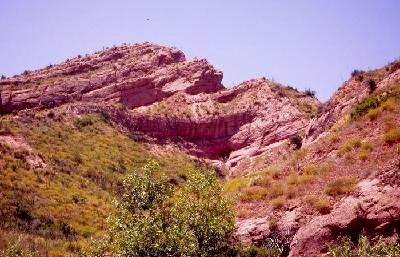Stratigraphy of the Eocene-Miocene Sespe Formation in the Santa Ana Mountains

Investigation of a set of stratigraphic sections of the Sespe Formation in the foothills of the northwestern Santa Ana Mountains indicate the presence of a major intraformational unconformity. Grad student Gino Calvano extracted land mammal fossils from overbank, flood plain, and paleosol deposits. The unconformity is shown by the occurrence of closely superposed fossil land mammal assemblages of widely disparate ages in. Late Uintan-late Duchesnean (late Middle Eocene) land mammal assemblages occur in the lower member of the Sespe Formation.
Early Arikareean and late Arikareean-early Hemingfordian (Early Oligocene-late Early Miocene) land mammal ages occur in the upper member, stratigraphically just above the land mammal assemblages in the lower member. The absence of land mammal assemblages of Chadronian-Whitneyan (Late Eocene-Early Oligocene) age in the intervening section in each of these 3 areas indicates that a major unconformity separates the lower member from the upper member.
The lower member is preserved at Santiago Canyon Road but not in outcrops to the south and east. A fault passing between these areas might explain the absence of the lower member in these areas. Integration of biostratigraphic and paleomagnetic data indicate that the lower member of the Sespe Formation is assignable to Chron C18r (41.1-40.0 Ma), the upper member to Chrons ClOn-ClOr (29.5-28.3 Ma), and that the unconformity represents at least 10 m.y., spanning the interval from 40.0-29.5 Ma. The timing of the erosional event correlates with the largest drop in sea level of the entire Phanerozoic Eon.





